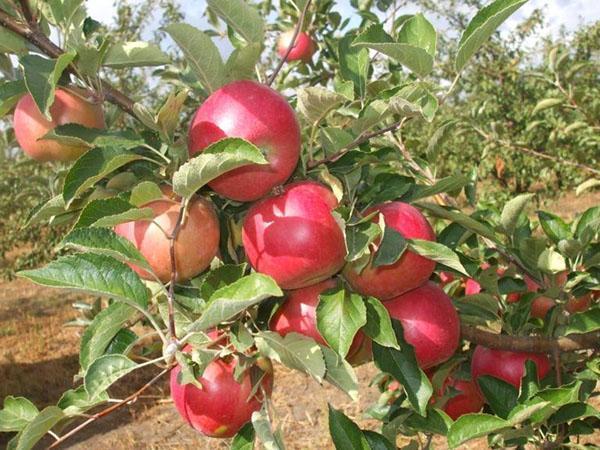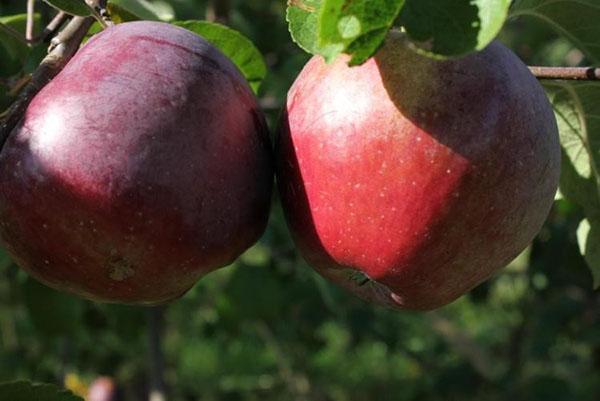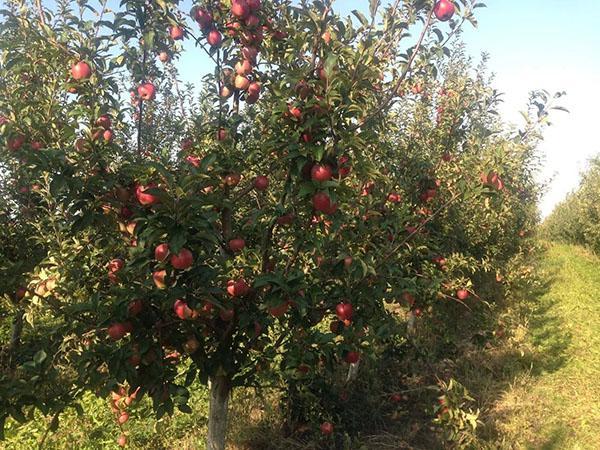Fruit trees for the garden - Gloucester apple tree
 When planning fruit plantings, each gardener thinks first of all about two questions: "What will this plant give me?" and "Will it take root in my garden?" The Apple tree Gloucester captivates not only with the beauty and aroma of flowering, but also with purely practical data - winter hardiness, productivity, unpretentious care, keeping fruits.
When planning fruit plantings, each gardener thinks first of all about two questions: "What will this plant give me?" and "Will it take root in my garden?" The Apple tree Gloucester captivates not only with the beauty and aroma of flowering, but also with purely practical data - winter hardiness, productivity, unpretentious care, keeping fruits.
Origin of the variety

Apple tree Gloucester - description and features
 The tree is fast-growing, with a crown diameter of up to 3 m and a height of about 2.5 m.With age, the pyramidal or oval crown is rounded, the branches are directed mainly upward, at an angle of 45-600 from the trunk. This is a fairly convenient plant for the garden, because the thickening and height of the crown often cause inconvenience when collecting fruits of a different variety.
The tree is fast-growing, with a crown diameter of up to 3 m and a height of about 2.5 m.With age, the pyramidal or oval crown is rounded, the branches are directed mainly upward, at an angle of 45-600 from the trunk. This is a fairly convenient plant for the garden, because the thickening and height of the crown often cause inconvenience when collecting fruits of a different variety.
The flowering period begins in the second half of May and the Gloucester apple tree adorns the garden for a long time with delicate pink fragrant inflorescences that attract a lot of insects. Each inflorescence has 3-4 buds, which open gradually. The fruits are tied on spears, twigs and ringlets.
 A description of the Gloucester apple tree would be frankly incomplete without a few words about the fruits themselves. Weight of 1 apple up to 200 gr. The shape is rounded, slightly elongated, ribs are pronounced in the upper part. The skin is glossy, dense and durable, the color is raspberry, or bright red, along the entire surface there are small light dots. The pulp is very juicy, crispy, yellow. Seeds are oval, medium size. The taste is intense sweet and sour.
A description of the Gloucester apple tree would be frankly incomplete without a few words about the fruits themselves. Weight of 1 apple up to 200 gr. The shape is rounded, slightly elongated, ribs are pronounced in the upper part. The skin is glossy, dense and durable, the color is raspberry, or bright red, along the entire surface there are small light dots. The pulp is very juicy, crispy, yellow. Seeds are oval, medium size. The taste is intense sweet and sour.
When harvested, the pulp is light with a greenish tinge, as it ripens and becomes yellow-creamy.
Reproduction, planting and care
 The variety is propagated by the stock both for dwarf trees and for medium-sized trees. In the first case, the harvest will be obtained for 3 years, in the second for 4. The maximum harvest is obtained for 10 years of a tree's life - up to 70 kg from each. This result is achieved in mono-plantings, when the trees remain self-pollinated, and their productivity is about 20% of flowering. If you plant pollinators nearby (Gala apple trees, Jonathan, Spartan, Idared), then you can expect a 30% increase in yield.
The variety is propagated by the stock both for dwarf trees and for medium-sized trees. In the first case, the harvest will be obtained for 3 years, in the second for 4. The maximum harvest is obtained for 10 years of a tree's life - up to 70 kg from each. This result is achieved in mono-plantings, when the trees remain self-pollinated, and their productivity is about 20% of flowering. If you plant pollinators nearby (Gala apple trees, Jonathan, Spartan, Idared), then you can expect a 30% increase in yield.
Do not wait for the maximum yield too quickly and say goodbye to the tree with low fruiting in the first years, perhaps the problem is pollination.
 Planting and caring for the Gloucester apple tree begins with an important task: you should choose what to strive for - the maximum birth or the beauty and fragrance of the garden.
Planting and caring for the Gloucester apple tree begins with an important task: you should choose what to strive for - the maximum birth or the beauty and fragrance of the garden.
For the practical gardener, the following ritual is required:
- 1 year: after the first flowering, all ovaries and buds are removed.
- 2 year: 70% removed.
- 3 year: 50% withdrawn.
For 4 years, all ovaries and flowers remain in place. This "barbaric" method actually gives the tree the opportunity to grow stronger and gain strength. The plant does not waste energy on fruiting, but develops a strong root system, strong branches and a trunk, which allows it to produce increased yields by the 4th year of life, acquire good immunity to diseases and weather conditions.
 When planting seedlings, it should be borne in mind that two-year-olds take more time to get used to than annuals. In addition, they should already have a developed root system, 2-3 healthy shoots from the trunk. The landing site should be protected from cold winds and well lit. Stagnant water, low gullies, shady and penumbra places can negate all efforts to obtain a high-quality harvest. In rainy climates, it is worth taking care of good drainage when planting. The ideal soil is loam or sandstone. But the apple tree is not very demanding on the composition and acidity of the soil.
When planting seedlings, it should be borne in mind that two-year-olds take more time to get used to than annuals. In addition, they should already have a developed root system, 2-3 healthy shoots from the trunk. The landing site should be protected from cold winds and well lit. Stagnant water, low gullies, shady and penumbra places can negate all efforts to obtain a high-quality harvest. In rainy climates, it is worth taking care of good drainage when planting. The ideal soil is loam or sandstone. But the apple tree is not very demanding on the composition and acidity of the soil.
Planting time is spring (before the buds open, in warm soil) or autumn (one month before the onset of the first frost).
Advantages and difficulties
 A fast-growing winter-hardy apple tree that perfectly tolerates frosts down to -200 C. If the temperature often drops below, then the yield can fall to critical values. This is where the difficulties end and only pluses remain.
A fast-growing winter-hardy apple tree that perfectly tolerates frosts down to -200 C. If the temperature often drops below, then the yield can fall to critical values. This is where the difficulties end and only pluses remain.
It is especially worth being afraid of spring frosts, when buds and shoots are already coming out.
The advantages of the Gloucester apple tree are unambiguously:
- winter hardiness;
- small crown volume and tree size;
- resistance to scab, an abundance of moisture and powdery mildew;
- great taste and long-term storage of fruits without processing.
Harvesting and storage
 Mass harvesting of apples occurs at the very end of September, but apples are gaining full maturity only by the month of January. In a cool place, the fruits are stored without special processing for 8 months. The Gloucester apple variety needs preliminary storage, they cannot be left on the branches until they are fully ripe.
Mass harvesting of apples occurs at the very end of September, but apples are gaining full maturity only by the month of January. In a cool place, the fruits are stored without special processing for 8 months. The Gloucester apple variety needs preliminary storage, they cannot be left on the branches until they are fully ripe.
The standard fruit tasting score is 4.5 points.
As part of the pulp:
- vitamins C, B, K, E;
- pectin;
- organic acids;
- in small doses of Mg, Fe, Na, Ca, Zn;
- antioxidants;
- fatty acid.
The apple cut does not darken immediately, the oxidation sites are poorly expressed, which indicates a low iron content.
Gloucester apples are great for growing in individual gardens as well as on an industrial scale. They will be an excellent fruit and vitamin supplement to the table in the winter-spring period, and are also great for homemade preparations including juices and dried fruits.